Sightseeing of Kazakhstan
Astana
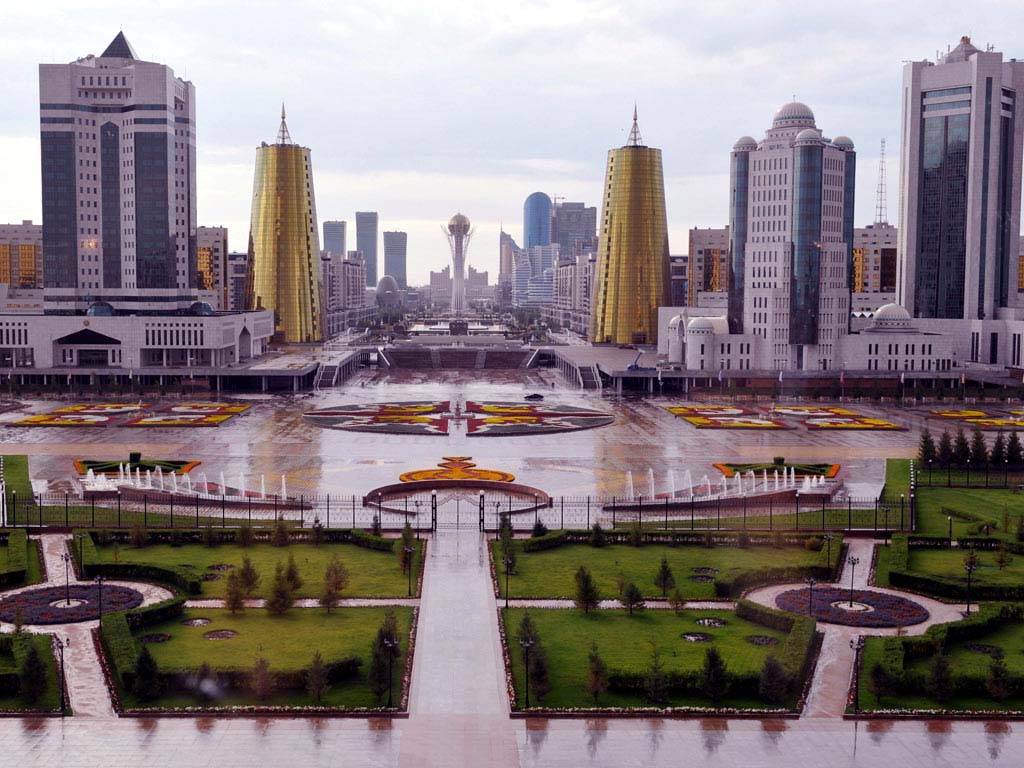
Astana, the capital of the Republic of Kazakhstan since 1997, is situated on a picturesque bank of the Ishim River. The town of Akmolinsk acquired incorporated status in 1862. It had long been famous for its fairs. Merchants from all regions of Kazakhstan, Russia and the Central Asian countries traveled here. As the development of virgin lands began, the town was renamed Tselinograd and typified the administrative center of an agricultural region.
Since acquiring the status of capital the city"s face has changed dramatically. The architects and builders working in the capital create wonderful architectural ensembles, which harmoniously combine modern design and oriental flair.
The Baiterek Tower has become the city"s symbol and its visiting card. The height of the structure is 105 meters. At the height of 97 meters there is an observation deck providing a bird"s eye view of the city. The figure of 97 was not chosen at random. It symbolizes the year of the movement of the capital from Almaty to Astana. The Baiterek Tower accommodates an art gallery, a large aquarium and a restaurant.
Astana has become one of the largest business centers in the region. All governmental organizations, the diplomatic missions of 44 countries and 113 joint ventures and foreign businesses are located here.
Every year the city hosts various international industrial exhibitions, conferences, musical contests and festivals of the Kazakhstani people.
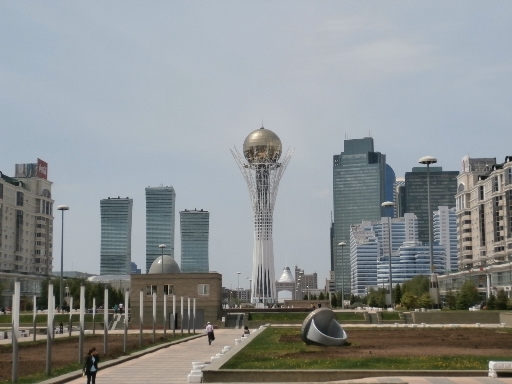
In 1999 by decision of UNESCO, Astana was awarded the title of World City. The city has an opera and Ballet Theater, a drama theater and a variety of museums. The monuments of Astana are a linking element between the new capital and its history, held in esteem by all the people of Kazakhstan.
Currently, many administrative buildings and business and entertainment centers are under construction in Astana. Among them is the Duman entertainment complex. It is a place for public recreation featuring an oceanarium, 3D movie theater, theater, area for slot machines and interactive games, multifunctional sideshow venue, bowling, night club, casino, hotel, cafes and restaurants and an indoor aquapark.
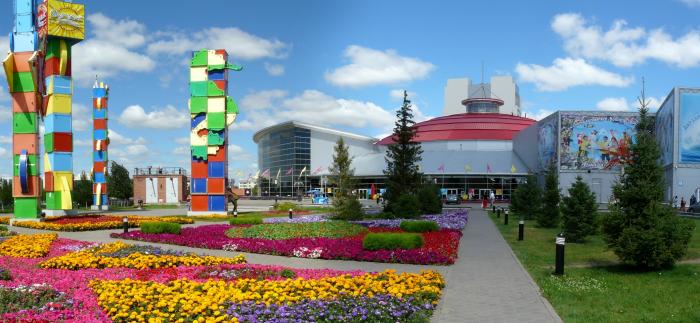
Another attraction of Astana is the ethnopark "Map of Kazakhstan - Atameken" representing a unique outdoor museum. The map area of 1.7 hectares features cities and historical memorials of Kazakhstan.
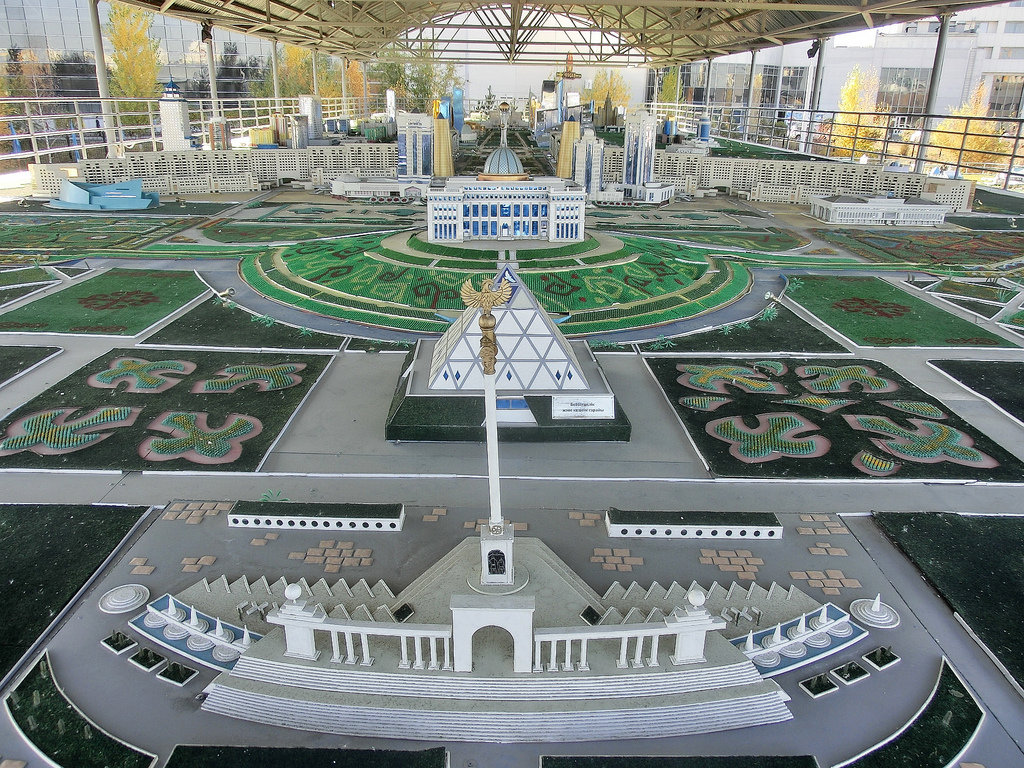
Khan Shatyr Shopping Center
Khan Shatyr Shopping and Entertainment Center is a new symbol of the capital of Kazakhstan, the first and the Only Lifestyle center in Astana that features world class shopping and entertainment under the same roof. Designed by famous British Architect, Lord Norman Foster, Khan Shatyr is the biggest tent in the world and also is the biggest shopping center in Kazakhstan. The main idea of Khan Shatyr is to create an atmosphere of comfort and antidote to the stress of daily life with the variety of greenery and fresh flowers. “Khan Shatyr” is located on the New Astana Center Axis which is also called “the Millennium Axis” with magnificent views of the Presidential Palace. The sand of the beach has been flown out from the Maldives and under floor heating gives the natural beach feeling when walking on the sand.
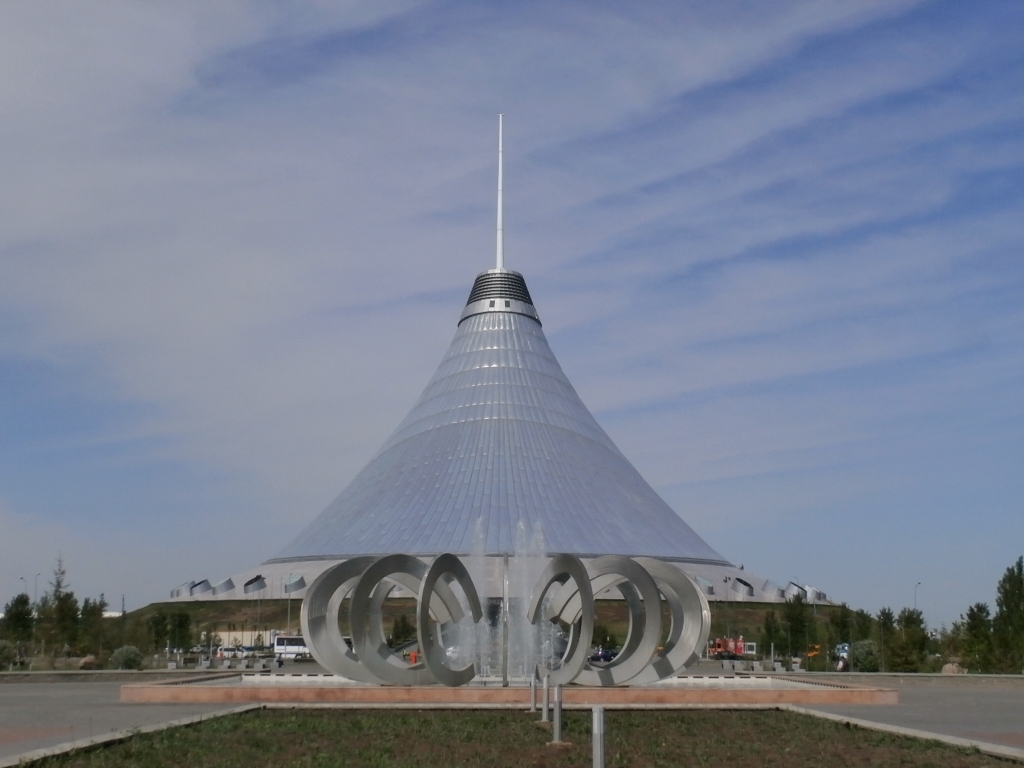
Almaty
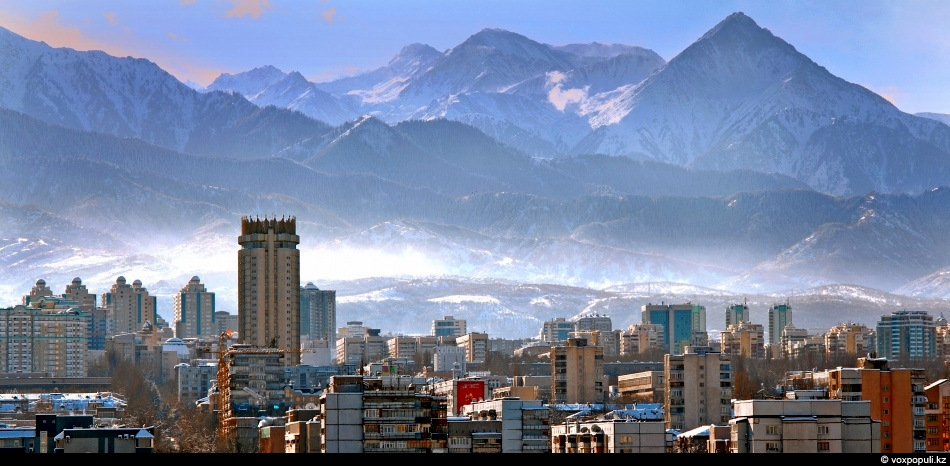
Almaty city is situated on the south-east of Kazakhstan, at the foot of Zayliyskiy Alatau. The city’s population numbers nearly 1,5 million people. Almaty was founded in 1854 as a Russian frontline fort in the district settled by nomads and was the capital of Kazakhstan till 1997.
At present the city remains financial, economic and cultural center of Kazakhstan. Almaty is a clean and tidy city with long straight avenues and beautiful parks. The mountains of the Zailiy Alatau rise as a wall along the south border of the city and make a beautiful background. Almaty has always considered a garden-city; even its name is translated from Kazakh like "father of apples". Since Kazakhstan became independent Almaty has began to develop swiftly as business and entertainment center of the republic. There is a big number of city centers, theaters, museums, art galleries, exhibition halls and countless entertainment facilities (cinemas, nightclubs, parks, restaurants, cafes, casinos), also stadiums, race tracks and mountain skating rink Medeo (it is situated on a height of 1700 meters above the sea level).
City’s point of interest is Panfilov Park, where the Orthodox Cathedral Zenkov is situated. This cathedral is one of few pre-revolutionary buildings remained after earthquake in 1911, due to it was built from wood without any nail.

In the Central State Museum is represented an exposition which represents history of Kazakhstan and the main archeological value of the state – "Gold Man". It is a soldier costume of 4 BC, founded in the Issikskiy tumulus.
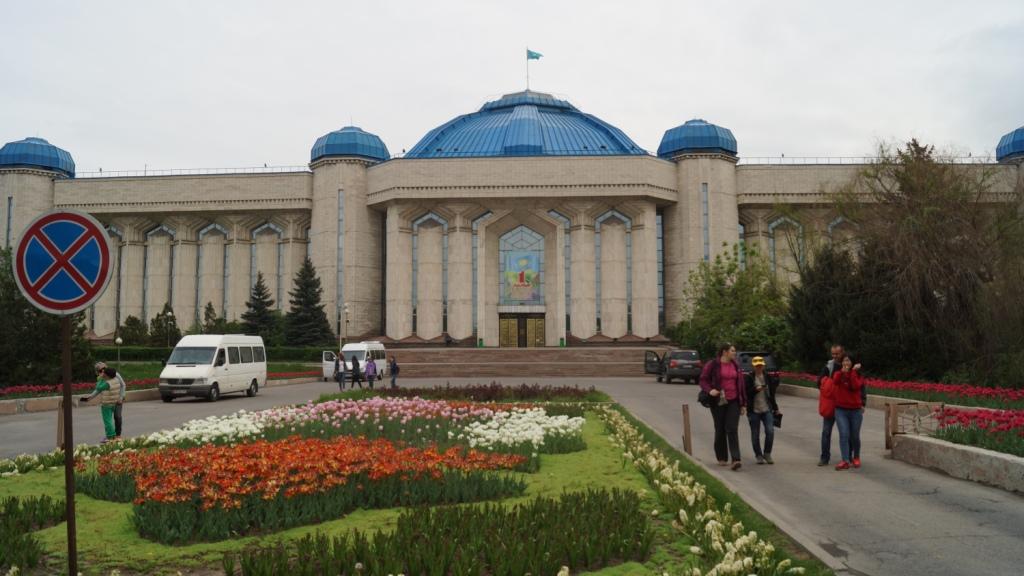
The Issikskiy tumulus is known as one of the biggest archeological finds of skif-saksian period. The find is dated by 4 BC. A young man buried there was a member of a ruling house The Great Kushan. "The Gold Soldier" was wearing a hauberk ornate by golden plaques, a belt with weapon from pure gold, oh the head – arrow-shaped gear. The costume consists from4 thousands of golden decorations, made in famous "animal style" typical for saksian craftspeople.
Outskirts of Almaty are picturesque. The city’s peak Kok-Tobe mountain (with famous Medeo sport complex) is situated at a height of 1130m, where it is possible to get by the rope-way. From this peak an amazing panorama of mountains and the city comes to light. Especially beautiful is there in the night, when the city is illuminated by colorful lights.
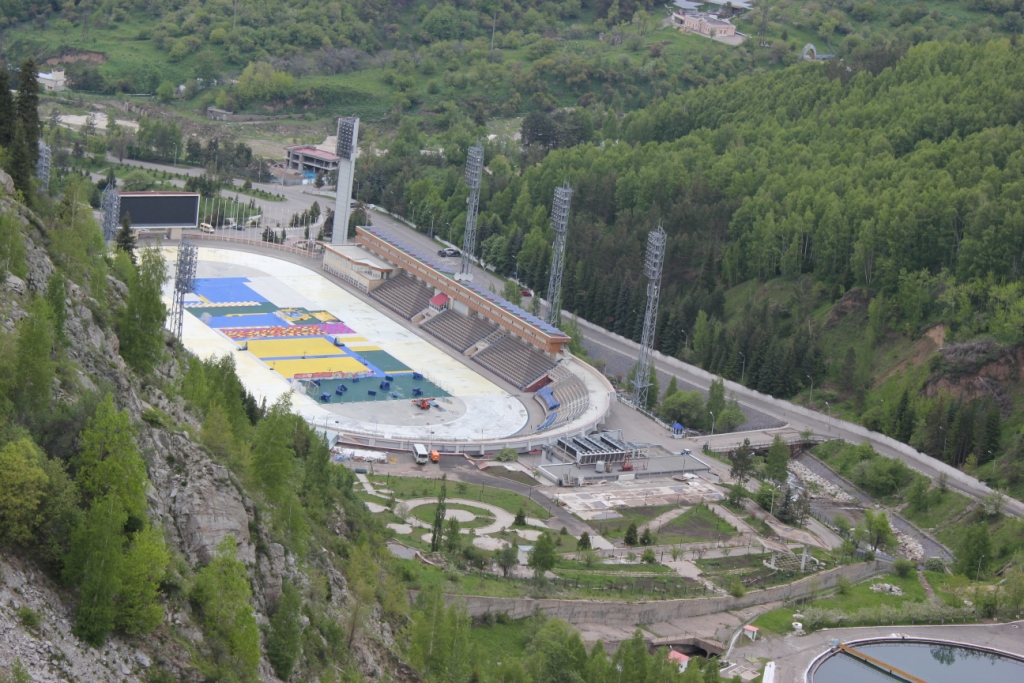
Two big rivers flow across the city – The Big and The Small Almatinka, which stream dawn from the mountains and provide fresh water to the city, filling the water stores and fountains with coolness and freshness.
In the ravine of the Small Almatinka are situated several spas and health resorts. Not far from Almaty, on a height of 2230m. Is situated a skiing place Chimbulak. A 1500 m. long rope-way operates there. It rises to a height of more then 3000 m, where a skiing descent begins from. From Chimbulak the road is going to the snowy peaks, which are popular among mountain-climbers.
In the ravine of the Big Almatinka at a height of 2511 m. above the sea level, 28,5 km to the south from Almaty, is situated the Big Almaty Lake.
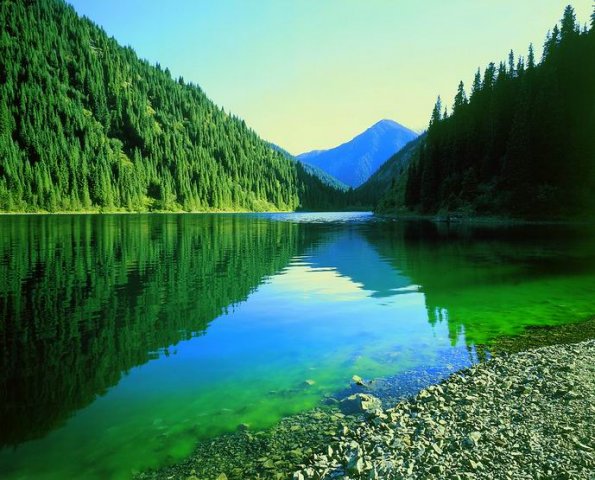
It is situated in the cavity like a sparkling mirror, surrounded by the mountain peaks on all sides. Three basic peaks rise over the lake: the Soviet Peak (4 317m.), the Lake Peak (4 110m.) and the Tourist Peak (3 954m.). It is possible to see them from the north side of the dam. To the west from a tourist is situated the ridge of the Big Almaty peak (a cairn of 3 681 m. high), which is observed well from the center of the city. Supplied by glacial water the lake represents a cup with the length of 1.6 km., width of about 1 km. and depth of 40 m. Depend on the season the lake’s color is changing from faintly-green to turquoise-blue. In the valley above the lake is situated a village with the spectacular cupolas of the Tian-Shan astronomical observatory (2 km. from the lake, at a height of 2 700m.). And higher (at a height of 3 300m), near the pass Jasilkezen, is Komostation, where it is possible to spend the night, observing stars.
The Turgen ravine
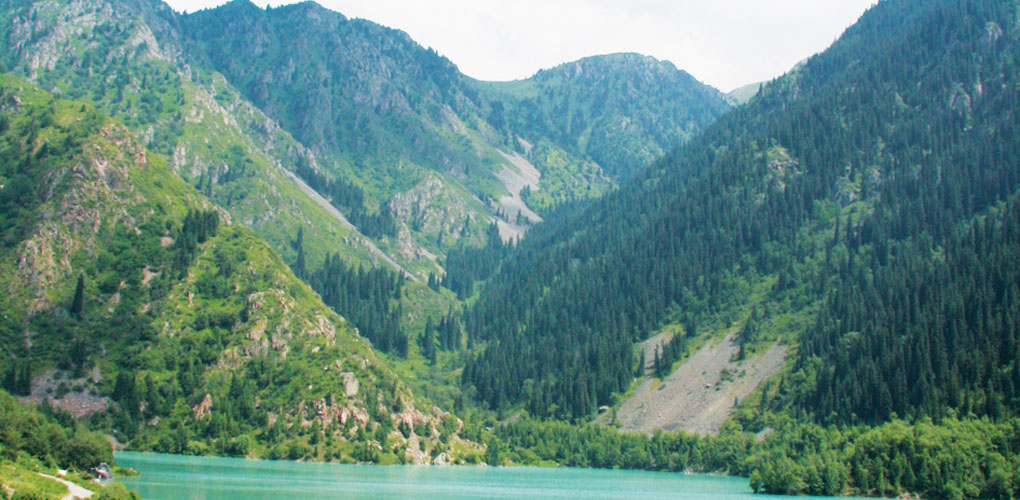
90 km far from Almaty is situated a beautiful place - The Turgen ravine. It is rich in hot wells, waterfalls, coniferous and mixed forests, alpine and subalpine meadows, lakes and springs, herbs and berries. It goes deep to 44 km till enormous table Assi. The Turgen ravine is famous by waterfalls, there are about seven. The waterfall Medvejiy attracts by its 30 meters height among pendent rocks and green firs. And the waterfall Bozgul is well known by strong water flow made a tunnel in the rock. The rocks have traces of the preglacial period’s plants. The ravine is known by Chin-Turgen fir-groves, spreading on the ground and making the complete firry carpet. The most popular place in the ravine is the Botan-eger station. Here, by the junction of three rivers, the Turgen ravine reaches the biggest depth – 920m.. There is an observatory on the table. Along the Assi river are ancient tumuluses and rock paintings. There are a lot of ancient saksian and usunian graves in the ravine. Also there is a trout farm in the Turgen ravine, where it is possible to fish and cook trout for dinner.
Charyn Canyon
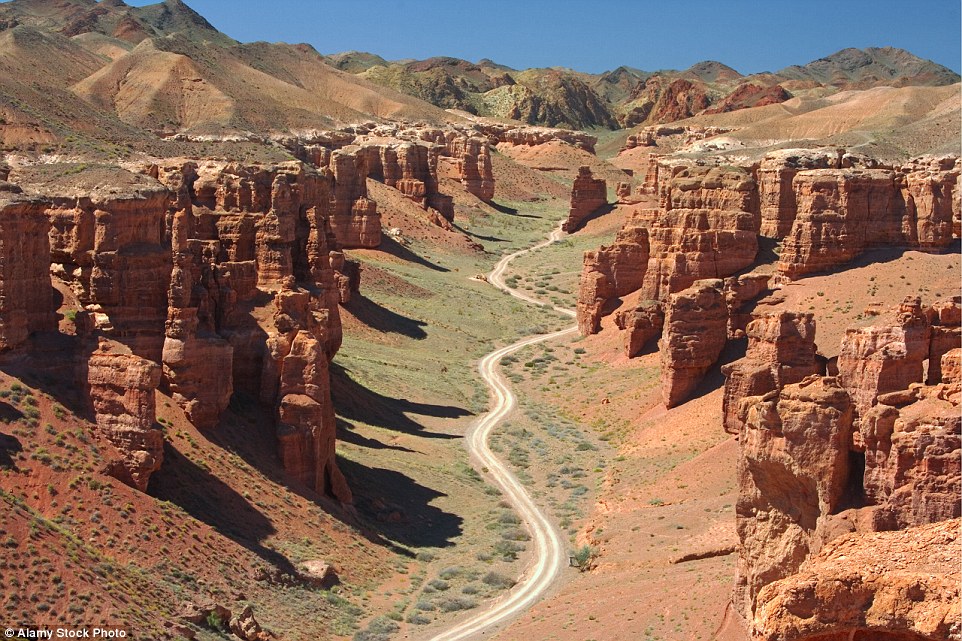
The Charyn Canyon is located in the Charyn National Park about 215km east of Almaty and approximately a 3 hour drive. The Canyon has been described as the Grand Canyon’s little brother. This is not to detract from the sheer splendor of the canyon itself. The vista of dramatic erosion made by the river Charyn below and the elements has created a dramatic and impressive landscape. The Canyon itself is approximately 150 km long, and, in places up to 300 meters deep.
One area of particular interest, is an area of 2km called the Valley of Castles, due to the pillars and rock formations forming imposing, almost man made structures.
The story of the Canyon is that it was formed about 3 million years ago as the land around the canyon started to rise. A very large lake existed in the area around the top of the canyon and it started to empty. Over the next million years the canyon was formed by the Charyn river. Approximately 2 million years ago a large earthquake disturbed the flow of the river by blocking it with a land-slip. The visitor part of the canyon then has suffered from the elements forming the rock sculptures. The Charyn River still flows at the bottom of the canyon forming the next great canyon. Because the area used to be a large inland sea, the deposits revealed on the sides of the canyon are relatively soft and are a geologists dream, revealing hundreds of millions of years of the earth’s history at this location.
The Issyk lake
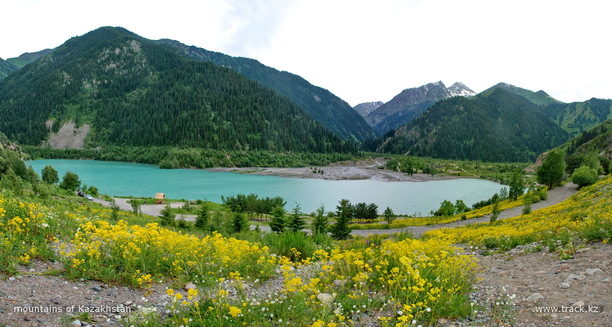
Only 60 km far from Almaty, near to small town Issyk, at a height of 1800 meter above the sea level, lies one of the most scenic lakes of the Zailiy Alatau. In 1963 from the glacier zone in the Upper Issik river came out a big mudflow. The enormous waves destroyed the natural dam and as effect, the lake was washed out. At present it is partly restored, but the beautiful scenery of the surrounding mountains cause joy to tourists.
Aksu-Djabagli
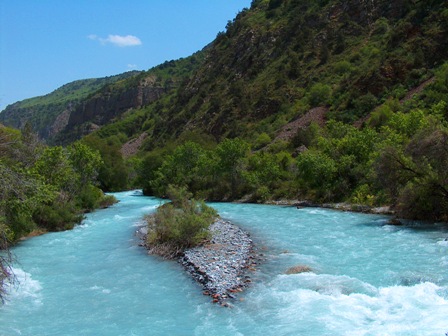
Aksu-Djabagli is the oldest reserve of Kazakhstan and the first in Central Asia received status of biospheric reserve of UNESCO is located in spurs of Western Tian Shan at height from 1000 up to 4280 meters above sea level ( located in the southern province of Kazakhstan). Its name is derived from the biggest river in the area, the Aksu, and the mountain chain Zhabagly which is located in the northern part of the area.). All general height zones are presented there. Semi-deserts are replaced by dry steppes, magnificent meadows give place to pine forests. Motley mosaic from multi-colored Alpine flowers decorates peaks’ bottom with dazzling snows and blue glaciers. Aksu Djabagli is the richest treasury of rare and disappearing species of animals and plants. It is habitat of argalis and mountain goats, marals and roe deers, lynxes and snow leopards, wolves and foxes, bears and porcupines, stone martens and ermines. The world of feathery is rich. Griffon-vultures, griffons and golden eagles live in the clouds. Snowcocks are met near to snowy areas. Flycatchers feathering seems to be alive spark in the shadow of trees. Rare species of colorful butterflies flit there.
The flora of reserve is various. Slopes are covered by a scarlet carpet of Grayg tulips.
In a difficult for access remote foundation trench at a height of 3000 meters above sea level there is one more sight of reserve - original "picture gallery", consisting from a set of drawings carved on dark brilliant stones. Wild and domestic animals, moments of hunting and a life of ancient people are represented on them. Hardened prints of ancient inhabitants – plants, fishes, insects and pangolins have been kept on paleontologic areas of Aksu-Djabagly.
Turkestan
Turkestan city (Yassy) was well-known as a mental-political center of the Turk people in the large region Dasht-i-Kipchak (Kipchak Steppe) and was the ancient capital of Kazakh Khans. Today Turkestan is 15000 years old. Sheikh Khodja Akhmed Yassaui – a poet, philosopher and spiritually mentor of the Turk people lived in this city.
Khodja Akhmed Yassaviy Mausoleum built by order of Tamerlan in 16 century is a masterpiece of Middle age architecture. It represents unique complex of palaces and temples, where decoration elegancy, patterned vaulted ceilings, colorful majolica mosaic are amazed.
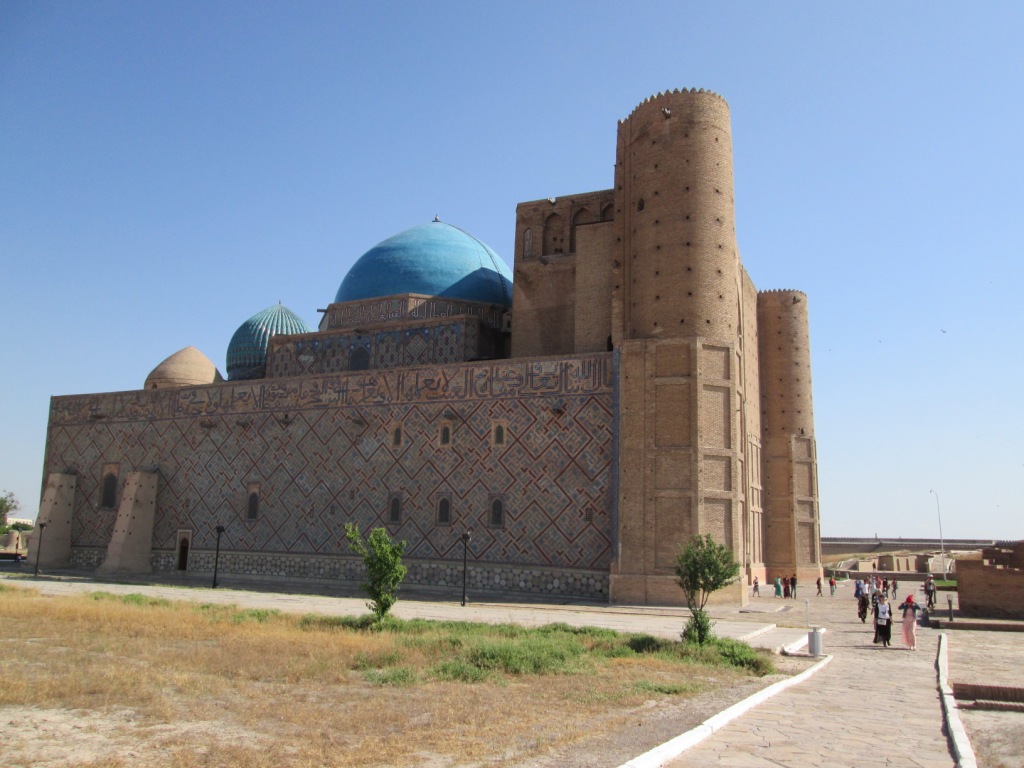
Otrar
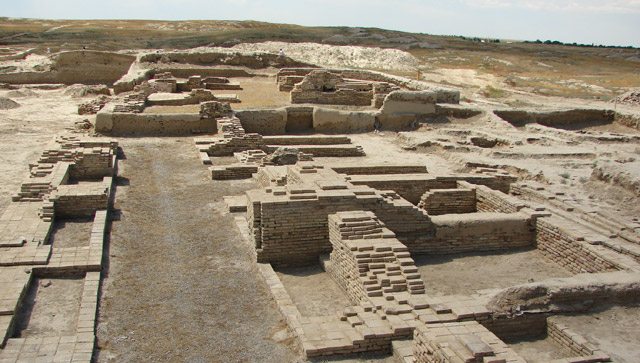
Otrar is one of most ancient cities of Central Asia. In Arab sources the city is call Farab. The first settlements in the place of the city appeared in the VIII century. The city was developing rapidly since it situated on one of the main branches of the Great Silk Road. By the XII century it already became a large trade center of crafts and art with palaces, caravansaries and cities blocks. One of the greatest places of interest of the city was Arystan-baba Mausoleum built by Timur.
There is a popular belief that the way to Turkestan must run through Arystan-Bab Mausoleum which was built on the grave of Akhmad Yassaui mentor, a famous religious mystic lived in 12 century. The earliest part of the mausoleum is related to the epoch of Timurids. The ruins of the city are located in the South of Kazakhstan near Talapty village. Near to it, there is a modern city of Turkestan, but in place of the city’s ruins only a desert and hot winds are dominating now. Here and there one can see ruins of medieval settlements, and the most impressive among them are the ruins of Otrar city.
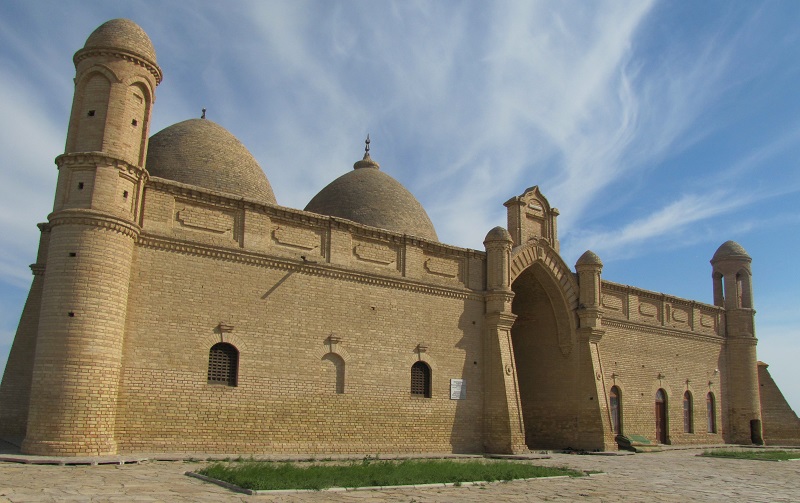
Taraz
Taraz city is more than 2000 years old. Since ancient time this city was known as “merchant town”. It is situated in South Kazakhstan, on the trade roads, leading to the South-East countries. The peak of the city’s development falls on 10-12 centuries, when it was the capital of Karakanid state.
Mausoleums of Karakhan and Davudbek, rulers’ palaces and many ancient burial grounds let a tourist plunge into faraway times.
Ancient architecture masterpieces mausoleums Babadji-Hatun and Aysha-bibi, included by UNESCO into the list of the world’s architecture rarities, have remained not far from today’s Taraz. Accordingly to a legend, the mausoleum Aysha-Bibi was built by one of the Karakhanid Dynasty rulers on the grave of his beautiful bridge Aysha-Bibi, who was a daughter of a Sufi poet Khakim-Ata and whose life came abruptly to an end on the way to her lover. The construction is totally tiled with carved terracotta slabs with plant and geometric patterns. The mausoleum looks out incredibly light and elegant. It has staid as a witness of ancient architects’ outstanding mastery for more then eight centuries in spite of winds and bad whether.
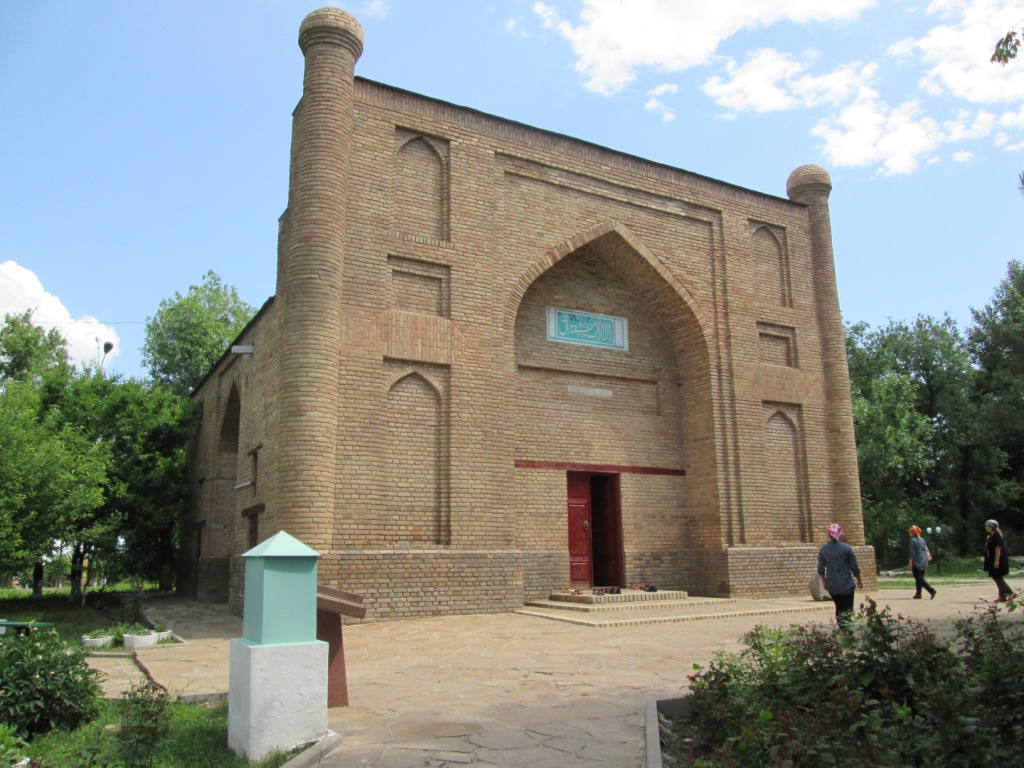
Baikanur
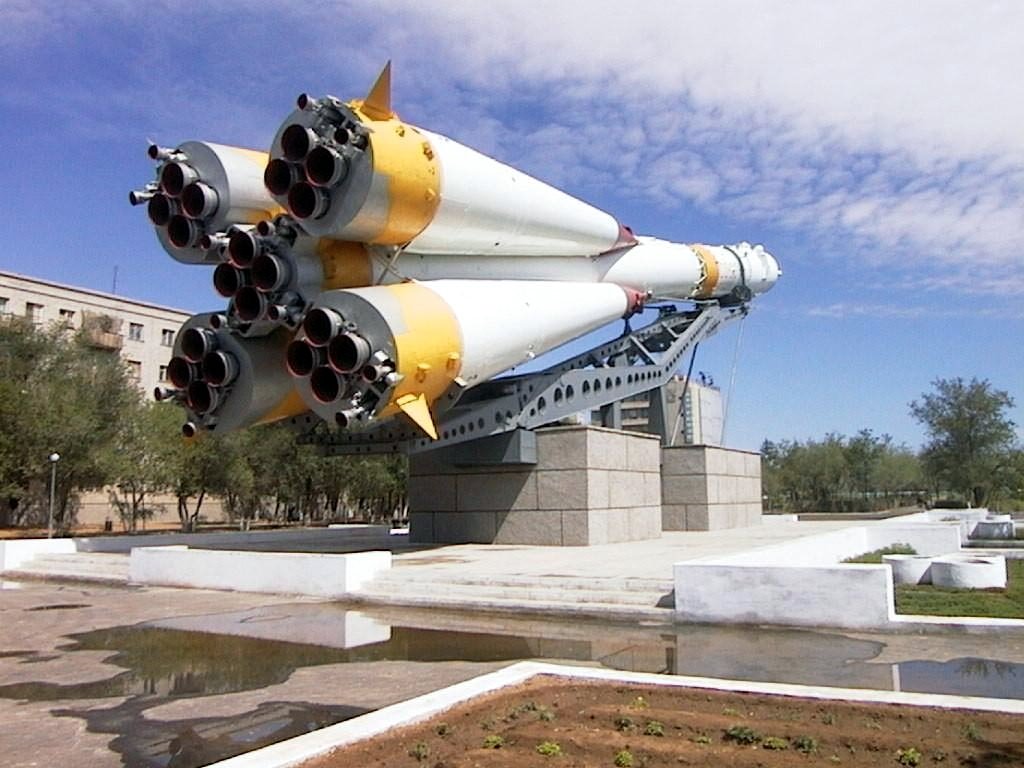
Situated in the steppes of Kyzylorda Province, Kazakhstan, 240 km west of the city of Kyzylorda, near the Tyuratam railway station, Baikonur is, probably, the world’s most famous spacecraft launch site (cosmodrome).
Present-day Baikonur comprises a huge spaceport and a cosy city with a population of over 70 thousand people, both leased to Russia until 2050.
The history of the city and cosmodrome began in 1955, when the USSR government decided to use the site for the construction of a training area to test intercontinental ballistic missiles. For secrecy reasons and in order to disorientate a probable enemy Baikonur was given different names at different periods of time – Tashkent-90, Zarya village, Zevezdograd village, Leninsk city and others. Since December 1995 the site has borne its present name Baikonur. Weapon testing went hand in hand with the testing of different types of non-military spacecraft. In 1957 the first artificial satellite was launched, and on 12 April 1961 the site became a starting ground for the first manned space flight Vostok piloted by Yuri Gagarin. By now, over 1,500 spacecraft, satellites and interplanetary probes, including orbital space stations Salyut and Mir, have been launched from the spaceport. Moreover, Baikonur has become a testing ground for all the 38 basic types of rockets and over 80 types of space machines, to say nothing of their modifications.
Since 2008 the Baikonur cosmodrome has never been used for military purposes, and its function now is only to launch international manned space flights Soyuz and cargo spaceships Proton.
With a special permit tourists may visit Baikonur to observe the start of launch vehicles.
The most interesting object is the museum of the city’s history with a big collection of 15,000 items illustrating how the city and cosmodrome were constructed.
Other attractions include squares, monuments and busts of Academicians S. Korolev and M. Yangel, the founders of the city and spacecraft designers, chief constructor G. Shubnikov and Marshal M. Nedelin, an original monument to Yuri Gagarin, life-size models of launch vehicles Soyuz and SS 17 (a prototype of the famous Satan ballistic rocket), memorials to pilots who died during test flights, Baikonur Arbat pedestrian street with a square and a monument to Lenin, the St. George the Victorious Orthodox Church, the Zero Gravity stela and Cosmonauts Alley.
Baikanur Cosmodrome
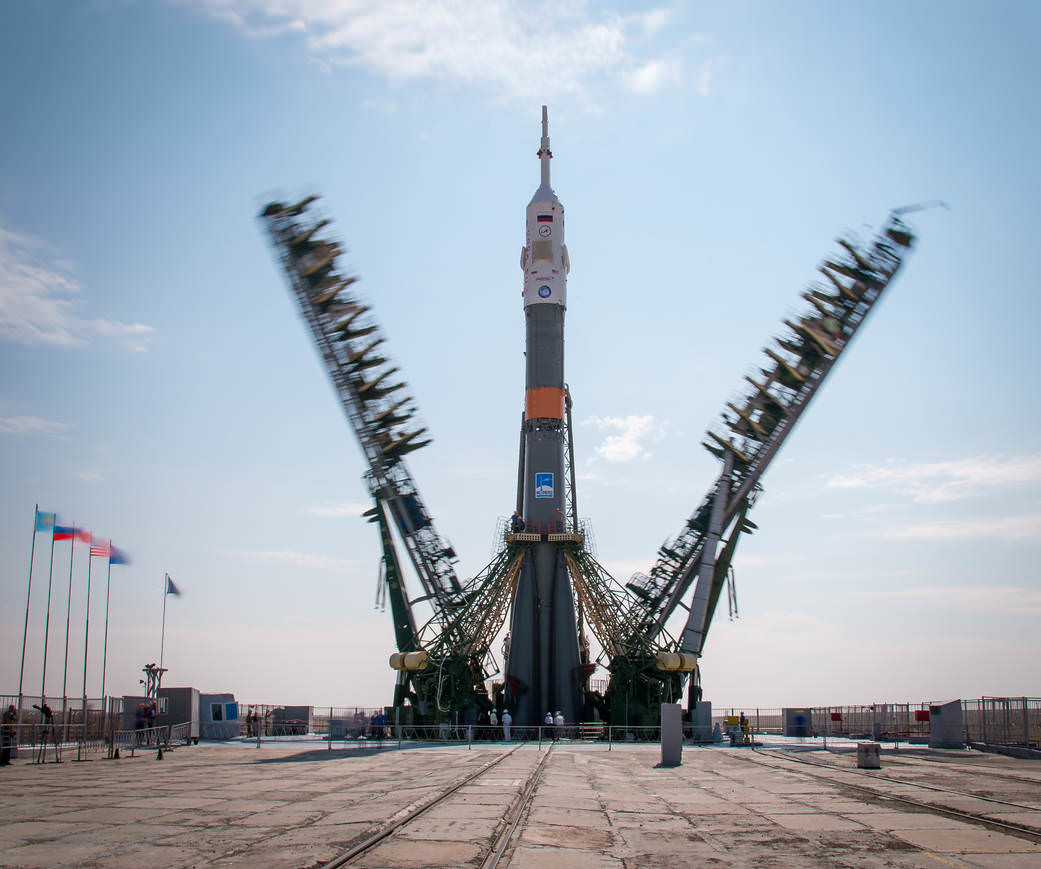
Gagarin’s Start (Site No. 1) where spacecraft Soyuz have been launched, the Energiya assembly and testing complex, the museum of cosmonautics (Baikonur cosmodrome) with unique exhibits, among which are the personal things of the first astronaut Yuri Gagarin, the first Earth satellite, the descent modules of spacecraft Soyuz, the modules of Belka and Strelka, the first canine cosmonauts, astronauts’ space suits, models of all launch vehicles, an original control panel used in the first manned space flight, a lunar globe and many other things. Within the museum complex are two cottages, in which S. Korolev and Yu. Gagarin lived when the first human flew into space. Right there you also have a chance of getting into the cockpit of space shuttle Buran.
